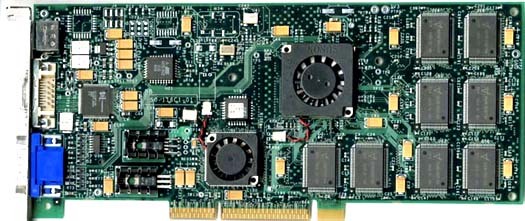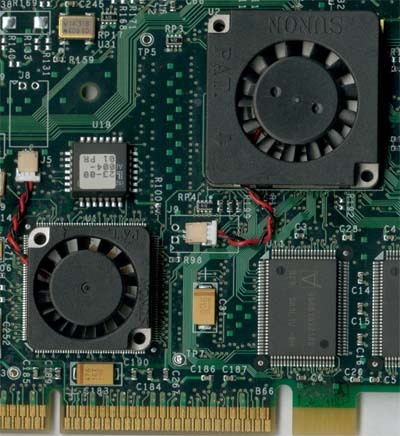Professional Affair: OpenGL Graphics Cards Compete
3Dlabs Oxygen GVX1
You can notice the difference to a mainstream game card quite clearly. The GVX1 is filled with computing and memory chips. The eight SGRAM memory modules on the right side of the picture only add up to 32 MByte, used for the frame buffer, the z-buffer and for textures.
The lower part of the picture shows the geometry processor GLINT Gamma G1. It delivers a maximum throughput of 4.75 Million lighted and transformed triangles per second. If necessary, 3DLabs uses its so-called PowerThreads technology. It is based on the OpenGL-ICD, allowing the CPU of the computer to execute a part of the geometry and lighting calculations. In this case the drivers utilize the SSE instructions of the Pentium III or the 3DNow! extensions of the AMD Athlon. The OpenGL drivers are also capable of multiprocessing and load balancing. As you are going to see later in the benchmarks, not every application profits from this technology, but under certain circumstances it is possible to use PowerThreads to optimize the performance. We want to point out here that other manufacturers also programmed load balancing between the CPU and the geometry processor. 3DLabs' marketing department just cleverly trademarked their method as (PowerThreads(. In principle it is not really that special.
The rasterization processor GLINT R3 is the processor with the largest fan. The R3 includes a 300 MHz Ramdac. It enables ergonomic refresh rates of 100 Hz up to a resolution of 1920x1080 pixel in True Color. The card supports resolutions up to 2048x1536, but then the refresh rate drops to a meager 60 Hz - not something the human eye should suffer for an extended time period. GLINT R3 possesses 7 independent DMA engines and a 128-bit wide memory interface. In our opinion the 32 MByte of video memory is not quite enough. The higher the resolution, the less is available for textures in the video memory of the GVX1. However, the card manages up to 256 MByte external texture memory via the AGP bus in the system memory. Therefore we recommend equipping a motherboard with at least 384 MByte RAM. And here is the first bottleneck already: The Oxygen GVX1 will never be capable of displaying large textures at high speed as soon as the resolution reaches 1600 x 1200. Let's take a look at the performance at 1280 x 1024.
Get Tom's Hardware's best news and in-depth reviews, straight to your inbox.
Current page: 3Dlabs Oxygen GVX1
Prev Page Driver Direction For OpenGL Cards Next Page 3Dlabs Oxygen GVX1 - DFP- And Stereo Connectors

